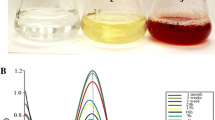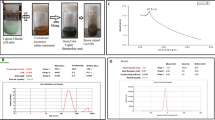Abstract
Antifungal impact of silver nanoparticles (AgNPs) was evaluated on the growth, morphological, and biomolecules dynamics of Fusarium culmorum and Alternaria alternata. It was revealed that the different concentrations of AgNPs caused inhibition of fungal growth and deformations of fungal structures especially at high concentrations 40 and 60 ppm of AgNPs. A. alternata conidiospores at 40 ppm of AgNPs was sharply deformed and their longitudinal sections disappeared. On the other hand, these fungi failed to produce conidiospores in the presence of 60 ppm of AgNPs but produced chlamydospores. The effect of AgNPs on amino and fatty acids of F. culmorum was investigated compared with the influence of silver nitrate (AgNO3). AgNPs at different applied concentrations stimulated the synthesis of the most detected amino acids including aspartic acid, threonine, serine, glutamic acid, glycine, alanine, valine, leucine, tyrosine, arginine, proline, and lysine. The concentration of detected amino acids increased with increasing AgNPs up to 60 ppm. Aspartic acid, serine, glycine, alanine, arginine, leucine, and proline concentrations were 11.52, 6.53, 21.51, 12.51, 27.34, 9.40, and 22.17 μg/ml compared with their concentrations 5.90, 0.34, 21.51, 12.51, 14.97, 6.86, and 9.91 μg/ml at 40 ppm of AgNPs and AgNO3, respectively. Numerous fatty acids were detected in low percentage in treated F. culmorum with AgNO3 or AgNPs compared with untreated (control). Only butyric was detected in high percentage (29.58 and 33.04% at 20 ppm of AgNPs and AgNO3, respectively) compared with their percentage 15.93% in control.



Similar content being viewed by others
References
Abdelghany, T. M., Aisha, M., Al-Rajhi, H., Al Abboud, M. A., Alawlaqi, M. M., Magdah, G., Helmy, E. A. M., & Mabrouk, A. S. (2017). Recent advances in green synthesis of silver nanoparticles and their. Applications: About Future Directions. A Review. BioNanoSci. https://doi.org/10.1007/s12668-017-0413-3
Ahmad, T., Wani, I. A., Manzoor, N., Ahmed, J., & Asiri, A. M. (2013). Biosynthesis, structural characterization and antimicrobial activity of gold and silver nanoparticles. Colloids and Surfaces B: Biointerfaces, 107, 227–234.
Narayanan, K. B., & Sakthivel, N. (2010). Biological synthesis of metal nanoparticles by microbes. Advances in Colloid and Interface Science, 156, 1–13.
Abdelghany, T. M. (2013). Stachybotrys chartarum: a novel biological agent for the extracellular synthesis of silver nanoparticles and their antimicrobial activity. Indonesian. Journal of Biotechnology, 18, 75–82.
Abdelghany, T. M., Abdel, R., Shater, M., Al Abboud, M. A., & Alawlaqi, M. M. (2013). Silver nanoparticles biosynthesis by Fusarium moniliforme and their antimicrobial activity against some food-borne bacteria. Mycopathologia, 11, 1–7.
Kumar, C. G., & Sujitha, P. (2014). Green synthesis of Kocuran-functionalized silver glyconanoparticles for use as antibiofilm coatings on silicone urethral catheters. Nanotechnology, 25(32). https://doi.org/10.1088/0957-4484/25/32/325101
Anna, O., Grzegorz, T., & Katarzyna, T. (2015). Antifungal properties of silver nanoparticles against indoor mould growth. Science of the Total Environment, 521–522, 305–314.
Kim, S., Jung, J., Lamsal, K., Min, J., & Lee, Y. (2012). Antifungal effects of silver nanoparticles against various plants pathogenic fungi. Mycobiology, 40, 53–58.
Raffi, M., Hussain, F., Bhatti, T. M., Akhter, J. I., Hameed, A., & Hasan, M. M. (2008). Antibacterial characterization of silver nanoparticles against E. coli ATCC-15224. Journal of Materials Science and Technology, 24, 192–196.
Kim, J., Lee, J., Kwon, S., & Jeong, S. (2009). Preparation of biodegradable polymer/silver nanoparticles composite and its antibacterial efficacy. Journal Nanoscience Nanotechnology, 9, 1098–1102.
Du, H., Lo, T. M., Sitompul, J., & Chang, M. W. (2012). Systems-level analysis of Escherichia coli response to silver nanoparticles: the roles of anaerobic respiration in microbial resistance. Biochemical and Biophysical Research Communications, 424, 657–662.
Zhi-Kuan, X., Qiu-Hua, M., Shu-Yi, L., De-Quan, Z., Lin, C., Yan-Li, T., & Rong-Ya, Y. (2016). The antifungal effect of silver nanoparticles on Trichosporon asahii. Journal of Microbiology, Immunology and Infection, 49, 182–188.
Ellis, M. B., & Ellis, J. P. (1985). Microfungi on land plants. Croom Helm, London & Sydney: An Identification Handbook.
John, F.L. & Brett, A.S. (2006). The fusarium laboratory manual, Blackwell Publishing Ltd.
Abd El-Mongy, M., & Abd El-Ghany, T. M. (2009). Field and laboratory studies for evaluating the toxicity of the insecticide Reldan on soil fungi. International Biodeterioration & Biodegradation, 63, 383–388.
Min, J., Kim, K., Kim, S., Jung, J., Lamsal, K., Kim, S., Jung, M., & Lee, Y. (2009). Effects of colloidal silver nanoparticles on sclerotium-forming phytopathogenic fungi. The Plant Pathology Journal, 25, 376–380.
Katarzyna, P., Sława, G., Magdalena, G., Tomasz, R., Adriana, N., Egemen, A., & Beata, G. (2016). Silver nanoparticles: a mechanism of action on moulds. Metallomics, (12), 1294–1302.
Sahar, M. O. (2014). Antifungal activity of silver and copper nanoparticles on two plant pathogens, Alternaria alternata and Botrytis cinerea. Research Journal of Microbiology, 9, 34–42.
Lamsal, K., Kim, S. W., Jung, J. H., Kim, Y. S., Kim, K. S., & Lee, Y. S. (2011). Application of silver nanoparticles for the control of Colletotrichum species in vitro and pepper anthracnose disease in field. Mycobiology, 39, 194–199.
Panácek, A., Kolár, M., Vecerová, R., Prucek, R., Soukupová, J., Krystof, V., Hamal, P., Zboril, R., & Kvítek, L. (2009). Antifungal activity of silver nanoparticles against Candida spp. Biomaterials, 30, 6333–6340.
Namasivayam, S. K. R., Ganesh, S., & Avimanyu, B. (2011). Evaluation of anti-bacterial activity of silver nanoparticles synthesized from Candida glabrata and Fusarium oxysporum. Journal of International Medical Research, 1, 131–136.
Chen, X., & Schluesener, H. J. (2008). Nanosilver: a nanoproduct in medical application. Toxicology and Applied Pharmacology, 176, 1–12.
Lok, C. N., Ho, C. M., Chen, R., He, Q. Y., Yu, W. Y., & Sun, H. (2006). Proteomic analysis of the mode of antibacterial action of silver nanoparticles. Journal of Proteome. Reserch, 5, 916–924.
Navarro, E., Flavio, P., Bettina, W., Fabio, M., Ralf, K., Niksa, O., Laura, S., & Renata, B. (2008). Toxicity of silver nanoparticles to Chlamydomonas reinhardtii. Environmental Science Technology, 42, 8959–8964.
Morones, J. R., Elechiguerra, J. L., Camacho, A., Holt, K., Kouri, J. B., & Yacaman, M. J. (2005). The bactericidal effect of silver nanoparticles. Nanotechnology, 16, 2346–2353.
Abdel Ghany, T. M., & Al Abboud, M. A. (2014). Capacity of growing, live and dead fungal biomass for safranin dye decolourization and their impact on fungal metabolites. Aust. J. Basic & Appl. Sci., 8, 489–499.
Habash, M. B., Park, A. J., Vis, E. C., Harris, R. J., & Khursigara, C. M. (2014). Synergy of silver nanoparticles and aztreonam against Pseudomonas aeruginosa PAO1 biofilms. Antimicrobial Agents and Chemotherapy, 58, 5818–5830.
Abdel-Ghany, T. M., Ganash, M., Bakri, M. M., and Al-Rajhi, A. M. H. (2018). Molecular characterization ofTrichoderma asperellum and lignocellulolytic activity on barley straw treated with silver nanoparticles. Bio Res., 13(1), 1729–1744.
Dorau, B., Arango, R., & Green III, F. (Eds.). (2004). Proceedings of the 2nd wood-frame housing durability and disaster issues conference. Forest Products Society, Las Vegas, NV, October, 4–6, 133.
Nancy, H., Philipp, H., Kristin, A., & Hermann, J. H. (2014). Effect of silver nanoparticles and silver ions on growth and adaptive response mechanisms of Pseudomonas putida mt-2. FEMS Microbiology Letters, 355(1), 71–77.
Author information
Authors and Affiliations
Corresponding author
Ethics declarations
Conflict of Interest
The authors declare that they have no conflict of interest.
Rights and permissions
About this article
Cite this article
Ganash, M., Abdel Ghany, T.M. & Omar, A.M. Morphological and Biomolecules Dynamics of Phytopathogenic Fungi Under Stress of Silver Nanoparticles. BioNanoSci. 8, 566–573 (2018). https://doi.org/10.1007/s12668-018-0510-y
Published:
Issue Date:
DOI: https://doi.org/10.1007/s12668-018-0510-y




